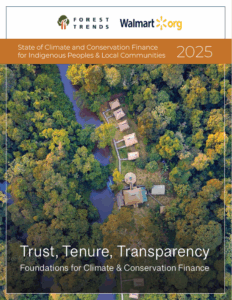State of Climate and Conservation Finance for Indigenous Peoples & Local Communities Report
Trust, Tenure, Transparency: Foundations for More Equitable Climate & Conservation Finance
By Arthur Blundell, Emily Harwell, Beto Borges, Debora Batista, Melissa Panhol View PublicationIndigenous Peoples and Local Communities (IPs & LCs) are recognized as some of the most effective stewards of forests and biodiversity, yet they continue to receive only a fraction of the funding that is meant to protect these ecosystems. This gap is more than a matter of fairness. It undermines the effectiveness of climate action, biodiversity conservation, and sustainable development worldwide.
In recent years, new initiatives and financing mechanisms have emerged that seek to recognize and address this imbalance. These include jurisdictional REDD+ programs, corporate non-governmental organization (NGO) partnerships, philanthropic commitments, and evolving carbon market standards that claim to center rights, participation, and equitable benefit sharing, including the shift from acknowledging IPs & LCs as mere beneficiaries to instead being recognized as co-designers and partners in projects and programs. Despite this progress, barriers remain, ranging from legal exclusion and limited recognition of customary land rights, to complex financial architectures that restrict IPs’ & LCs’ access.
The State of Climate and Conservation Finance for Indigenous Peoples and Local Communities 2025 surveys the current state of climate and conservation finance for IPs & LCs, mapping emerging opportunities, identifying critical gaps, and providing insights on how to move from fragmented pilot efforts to systemic, scaled, and just solutions. By centering IP & LC voices and priorities, and analyzing the flows of funding meant to support them, we aim to inform future investments that are not only effective, but fair, inclusive, and enduring. Strengthening IPs’ & LCs’ access to and control over funding is not only a matter of justice, but a prerequisite for achieving durable and scalable positive socioenvironmental results for everyone who directly benefits from the large-scale climate and nature benefits provided by forests.

